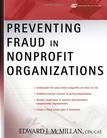非赢利诈骗
2006-12
John Wiley & Sons Inc
McMillan CPA CAE, Edward J.
220
Fraud or embezzlement discovered within a major corporation ultimately leads to front-page scandals and a few raised eyebrows. But the mere suggestion or evidence of fraud within a nonprofit can cause irreversible damage to its reputation, its support base, and, eventually, its very existence. Preventing Fraud in Nonprofit Organizations is the proactive manual your organization needs to detect fraud and prevent it from affecting your organization's bottom line and name. Brimming with details of hundreds of actual fraud and embezzlement schemes, it provides specific, practical advice on strengthening the areas in which your nonprofit may be most vulnerable. This hands-on guide shows nonprofit accountants, CFOs, financial consultants, board members, and managers how to: Know the four consistent areas of high risk Thoroughly evaluate their organization's system of internal controls Assemble a fraud examination team Document a fraud action plan Expose weaknesses that could lead to fraud Take corrective action to reduce the possibility of victimization Fraud deterrence is not exclusive to large corporations. Recommended reading for nonprofit professionals, Preventing Fraud in Nonprofit Organizations will motivate executives to take a fresh and intensive look at their organization's practices and act to protect from financial dishonesty.
Edward J. McMillan, CPA, CAE, is an experienced fraud examiner and teaches fraud prevention courses to organizations such as the American Institute of CPAs, the Maryland Association of CPAs, other state societies of CPAs, the U.S. Chamber of Commerce, and
About the AuthorAcknowledgmentsPrefaceDisclaimerAbout the Companion WebsiteSection 1: Not-For-Profit Organizations: Four Consistent Areas of High Risk Embezzlement: Who Does It and When Not-For-Profit Specific Issues Summary The Perpetrators: Who They Are, Why They Do It, and How They Are Caught The Embezzler’s “Window of Opportunity”Section 2: Statement of Auditing Standard No99 “Consideration of Fraud in a Financial Statement Audit” Statement of Auditing Standard No99 “Consideration of Fraud in a Financial Statement Audit”Section 3: Essential Internal Control and Administrative Procedures to Avoid Embezzlement The Background Check Conditions of Employment Agreement Conflicts of Interest Nepotism Whistleblowers Noncompete Agreements Confidentiality of Information Bonding Issues Signers on Bank Accounts Two-Signature Checks Lockbox Positive Pay Deposit Security and Restrictive Endorsements Check Stock Cash Transactions Cash Register Issues Insurance Committees Computer File Backups Check and Wire Transfer Signatures Inventory Issues Company Credit Cards Lines of Credit Bad Debt Policy Internal Audits Stop Payment Orders Voiding Checks Numbered Check Request Forms Expense Accounts CPA Management Letters Random Disbursement Checks CHECK 21Section 4: Clever Examples of Embezzlement Payroll Tax Deposits Check Switching Ghosts on the Payroll and Ghost Vendors The Danger of Acronyms Bank Account Reconciliations. Wie Transfers Postage Issues Kiting Manual Checks (Handwritten and Typed) Auditing ReceiptsSection 5: Steps to Take If You Have Been Victimized by Fraud Documenting a Fraud Action Plan Fraud Examinations and Assembling the Fraud Team The Basics of Forensic AccountingSection 6: Internal Control Analysis, Documentation, and Recommendations for Improvement Internal Control Analysis, Documentation, and Recommendations for ImprovementFraud GlossaryIndex
